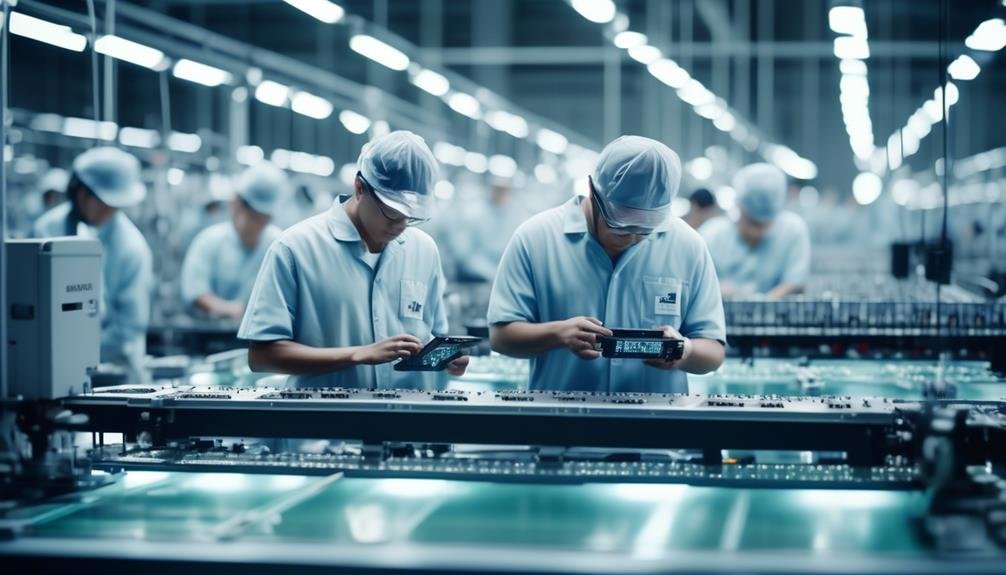Samsung Electronics: Quality Improvement Case Study
Samsung Electronics, a global leader in consumer electronics, has long been recognized for its commitment to innovation and quality. However, like any industry giant, the company has faced its share of quality improvement challenges.
In this case study, we will explore how Samsung Electronics identified opportunities for quality enhancement, implemented robust quality control measures, and leveraged technology to achieve excellence in their products.
By delving into the strategies and outcomes of their quality improvement initiatives, we can gain valuable insights into the complex world of quality management in the electronics industry and the lessons that can be applied to various business contexts.
Samsung Electronics: A Legacy of Innovation
Samsung Electronics has forged a legacy of innovation through its commitment to continuous technological advancement and groundbreaking product development. The company's journey towards innovation began with its inception, and it has consistently pushed the boundaries of what is possible in the tech industry.
Samsung's relentless pursuit of technological advancement is evident in its diverse range of products, from semiconductors and smartphones to home appliances and beyond. The company has consistently invested in research and development, driving progress in areas such as AI, 5G technology, and IoT. Samsung's ability to anticipate and meet the evolving needs of consumers has solidified its position as a global leader in innovation.
Furthermore, Samsung's legacy of innovation extends beyond product development. The company has actively contributed to shaping industry standards and technological ecosystems, driving progress and fostering collaboration within the tech community. By consistently delivering groundbreaking solutions, Samsung has cemented its reputation as a trailblazer in the global tech landscape.
This commitment to innovation not only sets Samsung apart but also paves the way for future advancements in technology.
Identifying Quality Improvement Opportunities
To identify quality improvement opportunities, Samsung Electronics must first analyze defects in production to pinpoint areas for enhancement.
Additionally, a comprehensive analysis of process efficiency is crucial to identify bottlenecks and inefficiencies.
Furthermore, a detailed examination of customer complaints can reveal valuable insights into areas that require improvement.
Defects in Production
Identifying and addressing defects in the production process is crucial for Samsung Electronics to continually improve the quality of its products. Effective defects management and production optimization are essential for ensuring customer satisfaction and maintaining a competitive edge in the market. The table below outlines key areas for identifying defects and optimizing production processes:
| Defects Management | Production Optimization |
|---|---|
| Root cause analysis | Automation |
| Quality control measures | Lean manufacturing |
| Defect tracking systems | Supply chain management |
| Continuous improvement | Technology integration |
| Employee training | Process standardization |
Process Efficiency Analysis
In the context of ensuring high-quality production, an essential aspect involves conducting a comprehensive analysis of process efficiency to identify opportunities for quality improvement. This entails a detailed examination of the manufacturing processes to streamline operations and enhance overall product quality. The analysis focuses on identifying areas for improvement and implementing changes to optimize efficiency and minimize waste.
Key elements of the process efficiency analysis include:
- Value Stream Mapping: Visualizing the production process to identify areas of improvement.
- Root Cause Analysis: Investigating the underlying reasons for inefficiencies or defects.
- Performance Metrics Tracking: Monitoring key performance indicators to assess process effectiveness.
- Standard Operating Procedures Review: Evaluating and updating procedures to ensure efficiency and quality.
- Continuous Improvement Initiatives: Implementing ongoing efforts to enhance processes and drive quality improvements.
This analytical approach enables Samsung Electronics to continuously enhance its operational efficiency and product quality.
Customer Complaints Analysis
Regularly monitoring and analyzing customer complaints is a crucial step in identifying opportunities for quality improvement at Samsung Electronics. By effectively addressing customer dissatisfaction, Samsung can enhance customer satisfaction and loyalty. The table below illustrates an example of a customer complaints analysis, outlining the types of complaints and their root causes.
| Type of Complaint | Root Cause |
|---|---|
| Product Defects | Manufacturing errors |
| Service Delays | Inadequate staffing levels |
| Technical Issues | Software glitches |
Analyzing customer complaints allows Samsung to pinpoint areas for improvement, such as streamlining manufacturing processes, optimizing service operations, and enhancing product development. This approach is essential for maintaining high-quality standards and continuously improving customer satisfaction. Identifying and addressing the root causes of complaints can lead to sustained quality enhancement and increased customer loyalty.
Implementing Robust Quality Control Measures
As Samsung Electronics aims to fortify its quality control measures, the focus will be on implementing process improvement strategies to enhance product quality and reliability.
This will involve the meticulous integration of robust quality control processes throughout the production cycle, ensuring that performance metrics are continuously tracked and analyzed to identify areas for improvement.
Ultimately, the goal is to establish a comprehensive framework that safeguards product quality and customer satisfaction.
Process Improvement Strategies
Implementing robust quality control measures is a critical component of Samsung Electronics' process improvement strategies, ensuring the consistent delivery of high-quality products to customers.
To achieve this, the company employs the following strategies:
- Continuous Improvement: Samsung Electronics focuses on constantly refining its processes to enhance product quality and customer satisfaction.
- Quality Assurance: The company utilizes stringent quality assurance protocols to detect and rectify any deviations from established quality standards.
- Data-Driven Approaches: Samsung Electronics leverages data analytics to identify trends and potential areas for improvement within its manufacturing processes.
- Employee Involvement: The company encourages active participation from employees at all levels to contribute ideas for process enhancement and quality control.
- Supplier Collaboration: Samsung Electronics collaborates closely with its suppliers to ensure the quality of incoming components, thereby maintaining high standards throughout the production process.
Quality Control Implementation
Employing a comprehensive framework of stringent quality control measures, Samsung Electronics ensures the consistent delivery of high-quality products to its discerning customer base.
The company has implemented a multifaceted approach to quality control, encompassing thorough testing at every stage of production, stringent adherence to industry standards, and a robust feedback mechanism from customers and market data.
Samsung Electronics emphasizes continuous improvement in quality control through the use of advanced technologies, such as automated inspection systems and machine learning algorithms to detect and address potential defects proactively.
Furthermore, the company has established a culture of quality consciousness among its employees, ensuring that every individual is committed to upholding the highest standards.
Performance Metrics Tracking
A meticulous tracking of performance metrics is essential for ensuring the efficacy and success of robust quality control measures within Samsung Electronics. To achieve this, the company utilizes a comprehensive approach to performance metrics tracking, encompassing various key aspects:
- Quality Control: Samsung Electronics focuses on tracking quality control metrics such as defect rates, customer complaints, and product returns to identify areas for improvement.
- Productivity Tracking: The company also diligently tracks productivity metrics, including production yield, cycle times, and equipment downtime, to optimize operational efficiency.
- Data Analysis: Utilizing advanced data analysis tools, Samsung Electronics examines performance metrics to identify trends, root causes of issues, and opportunities for enhancing product quality and productivity.
- Continuous Improvement: The company emphasizes the continuous monitoring and tracking of performance metrics to drive ongoing quality improvements and operational enhancements.
- Benchmarking: Samsung Electronics employs benchmarking techniques to compare performance metrics against industry standards and best practices, facilitating a proactive approach to quality control and productivity tracking.
Overcoming Quality Improvement Challenges
Samsung Electronics faced significant hurdles in overcoming quality improvement challenges, requiring a comprehensive and strategic approach to drive meaningful change.
One of the primary challenges was integrating quality control measures across diverse product lines and manufacturing processes. Samsung addressed this by implementing a unified quality management system that standardized quality control protocols, enabling the company to consistently monitor and improve product quality.
Additionally, risk management posed a significant challenge due to the global scale of Samsung's operations. To mitigate this, Samsung developed a robust risk assessment framework that identified potential quality risks at various stages of production and supply chain, allowing for proactive intervention to prevent quality issues.
Another obstacle was fostering a quality-centric culture across all organizational levels. Samsung tackled this by instituting extensive training programs and incentivizing employees to prioritize quality. Furthermore, the company established clear quality improvement goals and regularly communicated progress to drive accountability and motivation.
Leveraging Technology for Quality Enhancement
Leveraging advanced technological solutions has become imperative for achieving significant enhancements in product quality across diverse industry sectors. For Samsung Electronics, technology integration and quality assurance techniques have played a pivotal role in driving continuous quality improvement.
The following approaches highlight how leveraging technology has led to quality enhancement at Samsung Electronics:
- Implementation of advanced data analytics tools for real-time quality monitoring
- Integration of Internet of Things (IoT) for predictive maintenance and quality control
- Utilization of artificial intelligence (AI) for automated quality inspection and defect detection
- Adoption of virtual reality (VR) for immersive quality testing and training simulations
- Deployment of blockchain technology for transparent supply chain management and quality tracking
Monitoring and Evaluating Quality Performance
The implementation of advanced data analytics tools, integration of Internet of Things (IoT), and utilization of artificial intelligence (AI) have significantly influenced the monitoring and evaluating of quality performance at Samsung Electronics. Quality measurement at Samsung Electronics involves the continuous collection and analysis of data from various sources, such as production processes, customer feedback, and supply chain operations. This data is then used to assess the performance of products and processes in real-time, enabling prompt corrective actions when deviations from quality standards are identified.
Continuous improvement is a key focus in Samsung Electronics' quality monitoring and evaluation processes. Through the use of advanced analytics, the company is able to identify trends, patterns, and potential areas for improvement. Furthermore, AI algorithms are employed to predict and prevent quality issues before they occur, contributing to proactive quality management.
The integration of IoT allows for real-time monitoring of equipment and processes, providing valuable insights into the production environment. This comprehensive approach to quality performance monitoring and evaluation enables Samsung Electronics to consistently enhance the quality of its products and processes, thus maintaining its position as a leader in the electronics industry.
Achieving Excellence: Quality Improvement Outcomes
Consistently delivering high-quality products and processes is the ultimate goal of Samsung Electronics' commitment to continuous improvement and proactive quality management. The company has implemented various quality improvement strategies and continuous improvement initiatives to achieve excellence in its outcomes.
Some of the key outcomes of these efforts include:
- Enhanced Product Quality: Through rigorous quality control measures and continuous monitoring, Samsung Electronics has significantly improved the overall quality of its products, leading to higher customer satisfaction and loyalty.
- Streamlined Processes: The implementation of lean manufacturing principles and process optimization techniques has resulted in streamlined operations, reduced waste, and improved efficiency across the organization.
- Improved Supplier Relationships: Samsung Electronics has focused on building strong partnerships with its suppliers, fostering collaboration, and ensuring that high-quality standards are maintained throughout the supply chain.
- Enhanced Employee Engagement: By promoting a culture of continuous improvement and providing employees with the necessary training and resources, Samsung Electronics has seen increased employee engagement and contribution to quality enhancement efforts.
- Market Leadership: As a result of its relentless pursuit of quality excellence, Samsung Electronics has solidified its position as a market leader, setting industry benchmarks for quality standards and innovation.
Conclusion
Through robust quality control measures, Samsung Electronics has been able to achieve excellence in quality improvement.
By leveraging technology and continuously monitoring and evaluating quality performance, the company has established a legacy of innovation in the industry.
Like a master craftsman refining a diamond, Samsung has honed its quality improvement processes to achieve brilliance in its products, setting a standard for others to follow.







